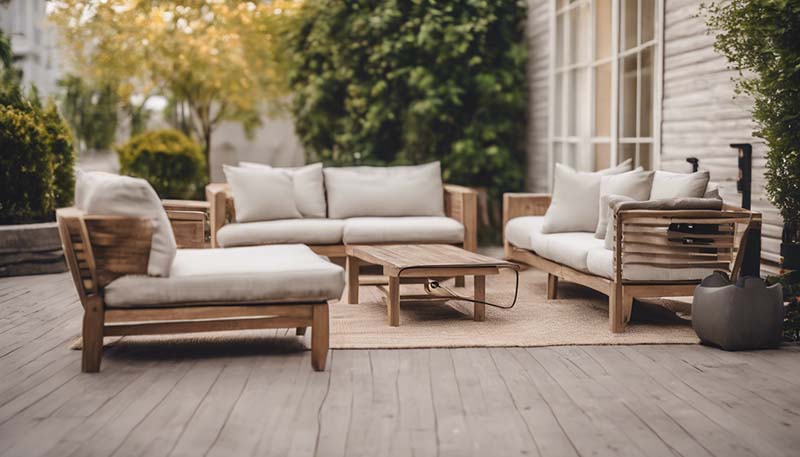How to Choose the Perfect Outdoor Furniture for Your Space
How to Choose the Perfect Outdoor Furniture for Your Space
Choosing the perfect outdoor furniture is an essential aspect of creating a comfortable and inviting outdoor living space. It's not just about aesthetics; the right furniture can enhance the functionality and enjoyment of your outdoor area. Here's a comprehensive guide to help you make the best choices for your outdoor space.
1. Assess Your Space
Before you start shopping, it's crucial to evaluate your outdoor space. Consider the following:
- Size: Measure your space to understand how much furniture you can accommodate without making the area feel cramped.
- Layout: Think about how you want to use the space. Will it be for dining, lounging, or entertaining?
- Sun and Shade: Note where the sun shines and where there's shade throughout the day, as this will affect the type of furniture and materials you choose.
- Wind and Weather: Are there areas that are more sheltered from the wind or weather? This can help you decide where to place your furniture.
2. Determine Your Style
Your outdoor furniture should reflect your personal style and complement the architecture of your home. Look at different design styles:
Advertisement
- Traditional: Classic and timeless, often featuring rich colors and ornate details.
- Modern: Clean lines, simple shapes, and a focus on functionality.
- Rustic: Natural materials and a rugged, cozy feel.
- Coastal: Light, airy, and often featuring elements that evoke a beachy vibe.
3. Consider the Materials
The materials your outdoor furniture is made from will greatly affect its durability, maintenance, and appearance. Some popular choices include:
- Wood: Offers a natural look but requires more maintenance to prevent weather damage.
- Metal: Durable and low-maintenance, but can get hot in the sun or cold in the shade.
- Plastic/Resin: Lightweight and affordable, but may not be as sturdy or attractive as other materials.
- Wicker/Rattan: Offers a classic look and can be very comfortable with cushions.
- Aluminum: Lightweight, durable, and resistant to rust.
4. Choose the Right Fabrics
When selecting cushions and upholstery for your outdoor furniture, choose fabrics that are weather-resistant and easy to clean:
- Sunbrella: Known for its durability and fade resistance.
- Canvas: Breathable and casual, but may require more frequent cleaning.
- Synthetic Materials: Often treated to be water-resistant and mildew-resistant.
5. Prioritize Comfort
Comfort is key when it comes to outdoor furniture. Look for:
- Cushions: Deep, plush cushions for lounging, or firmer ones for dining.
- Adjustable Features: Reclining chairs or adjustable umbrellas can provide extra comfort and functionality.
- Support: Good back and lumbar support for long periods of use.
6. Think About Maintenance
Low-maintenance furniture can save you time and effort. Consider:
- Materials: Some materials require less upkeep, like powder-coated aluminum or teak wood.
- Covering Options: Invest in weather-resistant covers to protect your furniture when not in use.
- Cleaning: Choose furniture that can be easily cleaned, either with a hose or mild detergent.
7. Budget and Quality
Set a budget before you start shopping and remember that investing in quality can save you money in the long run:
- Durability: High-quality materials will last longer and resist weather damage.
- Warranty: Check the warranty offered by the manufacturer for coverage on defects and weather damage.
- Reviews: Look at customer reviews to gauge the quality and durability of the furniture.
8. Add Accessories
Complete your outdoor space with accessories that enhance both function and style:

- Umbrellas: Provide shade and can double as a decorative element.
- Outdoor Rugs: Define the space and add a touch of warmth and comfort.
- Lighting: Outdoor lighting can extend your usable hours and create a welcoming atmosphere.
- Planters: Add life and color to your space with potted plants or a vertical garden.
9. Consider Portability
If you have a small space or move your furniture around frequently, consider furniture that is easy to move:
- Lightweight Pieces: Folding chairs or lightweight tables can be easily rearranged.
- Rolling Options: Some furniture comes with wheels for easy movement.
10. Plan for the Future
Finally, think about how your needs might change in the future and choose furniture that can adapt:
- Expandable Sets: Some furniture sets can be expanded with additional pieces as your needs grow.
- Multifunctional: Furniture that serves multiple purposes, like a bench with storage or a table that can be used as a seat, can be a space-saver.
- Trends: While it's important to choose something you love, avoid trends that might quickly go out of style if you plan to sell your home in the future.
By considering these factors, you can create an outdoor living space that is not only beautiful but also functional and enjoyable for years to come.
Note: This article is for informational purposes only and does not constitute professional advice. Always do your own research or consult with a professional when making decisions about outdoor furniture.